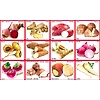Root Vegetables
0.58
0.60
You Save: 0.02. Discount: 3.33%
-
Product is not available
Country Of Origin : India
Root vegetables are a diverse group of vegetables that grow underground and are known for their hearty flavors, starchy textures, and nutritional richness. Here's a description and specifications for root vegetables:
- Carrots
- Potatoes (e.g., Russet, Yukon Gold, Sweet Potatoes)
- Beets
- Turnips
- Radishes
- Parsnips
Description:
- Appearance: Root vegetables come in various shapes, sizes, and colors, but they typically have a bulbous or elongated shape with a rough outer skin. Examples include carrots, potatoes, beets, radishes, turnips, and sweet potatoes.
- Texture: Root vegetables have a dense, firm texture with varying degrees of starchiness. Some, like potatoes and sweet potatoes, are soft and creamy when cooked, while others, like carrots and turnips, are crisp and crunchy.
- Flavor: Root vegetables offer a range of flavors, from earthy and nutty to sweet and peppery. The flavor intensifies when cooked, with some varieties developing caramelized or roasted notes.
- Aroma: When raw, root vegetables have a subtle, earthy aroma that is characteristic of their underground growth. The aroma becomes more pronounced when they are cooked.
Specifications for Culinary Use:
- Cleaning: Root vegetables should be thoroughly washed under running water to remove any dirt, debris, or pesticides from the surface. It's essential to scrub them with a brush to remove any stubborn dirt.
- Preparation: Root vegetables can be eaten raw in salads or slaws, or cooked in a variety of dishes such as soups, stews, roasts, and gratins. They can be peeled, chopped, sliced, grated, or mashed, depending on the recipe.
- Cooking Time: Cooking times vary depending on the type of root vegetable and the desired texture. Some varieties, like potatoes and sweet potatoes, cook relatively quickly, while others, like beets and turnips, benefit from longer cooking times to soften and develop their flavors.
- Flavor Pairings: Root vegetables pair well with a wide range of ingredients, including garlic, onions, herbs, spices, citrus fruits, nuts, and cheeses. They can be seasoned with salt, pepper, olive oil, butter, and vinegar to enhance their flavor.
- Nutritional Value: Root vegetables are highly nutritious and are rich in vitamins, minerals, and antioxidants. They are an excellent source of complex carbohydrates, dietary fiber, vitamin C, vitamin A, potassium, and other essential nutrients. Root vegetables are also low in fat and calories, making them a healthy choice for a balanced diet.
Storage:
- Root vegetables should be stored in a cool, dark place, such as a pantry or cellar, to maintain their freshness and flavor. They can be stored in a breathable bag or container to prevent them from drying out or sprouting.
- It's best to store root vegetables away from other fruits and vegetables, as they can emit ethylene gas, which can cause premature ripening and spoilage.
It's essential to inspect root vegetables regularly for any signs of spoilage, decay, or sprouting. Discard any vegetables that show signs of deterioration to prevent them from affecting the quality of other vegetables.



